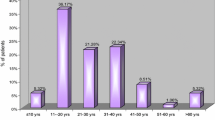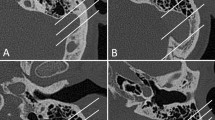Abstract
Backgrounds
Some disorders, such as otitis media and Eustachian tube dysfunction, may cause the temporal bone to become sclerotic. A sclerotic temporal bone has the tendency to shrink. The aim of this study was to evaluate the morphologic changes that result from sclerosis of the temporal bone.
Methods
We measured 9 variables on 2 axial images, and 8 variables on 2 coronal images in healthy ears and diseased ears in 37 patients with unilateral chronic otitis media. We also measured the volume of mastoid pneumatization.
Results
The distance from sigmoid sinus to Henle’s spine was correlated to the degree of volume reduction, and it accounted for about 17.7% of the total variation in volume reduction. There was no difference in the sigmoid sinus type in comparisons between sclerotic and pneumatic mastoids.
Conclusions
The sclerosis of the temporal bone was observed to reduce the volume of the mastoid pneumatization. However, a large portion of the volume reduction may result from the sclerotic change in the air cell system, rather than from shrinkage of the mastoid bone. Therefore, the location of surgically-important structures, in the middle and inner ear, is only rarely changed in sclerotic temporal bone.


Similar content being viewed by others
References
Aoki K, Esaki S, Morikawa K, Kikuti Y, Honda Y (1988) Process of the development of pneumatization in human fetal temporal bone: compared with the results of pneumatization by the experimental study of the pigs. J Otolaryngol Jpn 91:1220–1227
Aoki K, Esaki S, Honda Y, Tos M (1990) Effect of middle ear infection on pneumatization and growth of the mastoid process. An experimental study in pigs. Acta Otolaryngol 110:399–409
Austin DF (1977) On the function of the mastoid. Otolaryngol Clin North Am 10:541–547
Bayramoglu I, Ardic FN, Kara CO, Ozuer MZ, Katircioglu O, Topuz B (1997) Importance of mastoid pneumatization on secretory otitis media. Int J Pediatr Otorhinolaryngol 40:61–66
Diamant M (1940) Otitis and pneumatization of mastoid bone. Acta Otolaryngol 41:10
Ichijo H, Hosokawa M, Shinkawa H (1993) Differences in size and shape between the right and left sigmoid sinuses. Eur Arch Otorhinolaryngol 250:297–299
Ichijo H, Hosokawa M, Shinkawa H (1996) The relationship between mastoid pneumatization and the position of the sigmoid sinus. Eur Arch Otorhinolaryngol 253:421–424
Lee DH, Jun BC, Kim DG, Jung MK, Yeo SW (2005) Volume variation of mastoid pneumatization in different age groups: a study by three-dimensional reconstruction based on computed tomography images. Surg Radiol Anat 27:37–42
Shatz A, Sade J (1990) Correlation between mastoid pneumatization and position of the lateral sinus. Ann Otol Rhinol Laryngol 99:142–145
Silbiger H (1950) Uber das ausmass der mastoid pneumatisation beim menschen. Acta Anat 11:215–223
Sirikci A, Bayazit YA, Kervancioglu S, Ozer E, Kanlikama M, Bayram M (2004) Assessment of mastoid air cell size versus sigmoid sinus variables with a tomography-assisted digital image processing program and morphometry. Surg Radiol Anat 26:145–148
Tos M, Stangerup SE (1985) The causes of asymmetry of the mastoid air cell system. Acta Otolaryngol 99:564–570
Turgut S, Tos M (1992) Correlation between temporal bone pneumatization, location of lateral sinus and length of the mastoid process. J Laryngol Otol 106:485–489
Author information
Authors and Affiliations
Corresponding author
Additional information
Presented as a poster titled as “analysis of morphologic changes in the sclerotic temporal bone by spiral high-resolution computed tomography” at XVIII IFOS World Congress (June 25–30, 2006, Rome, Italy).
Rights and permissions
About this article
Cite this article
Lee, DH., Jung, MK., Yoo, YH. et al. Analysis of unilateral sclerotic temporal bone: how does the sclerosis change the mastoid pneumatization morphologically in the temporal bone?. Surg Radiol Anat 30, 221–227 (2008). https://doi.org/10.1007/s00276-008-0310-0
Received:
Accepted:
Published:
Issue Date:
DOI: https://doi.org/10.1007/s00276-008-0310-0




